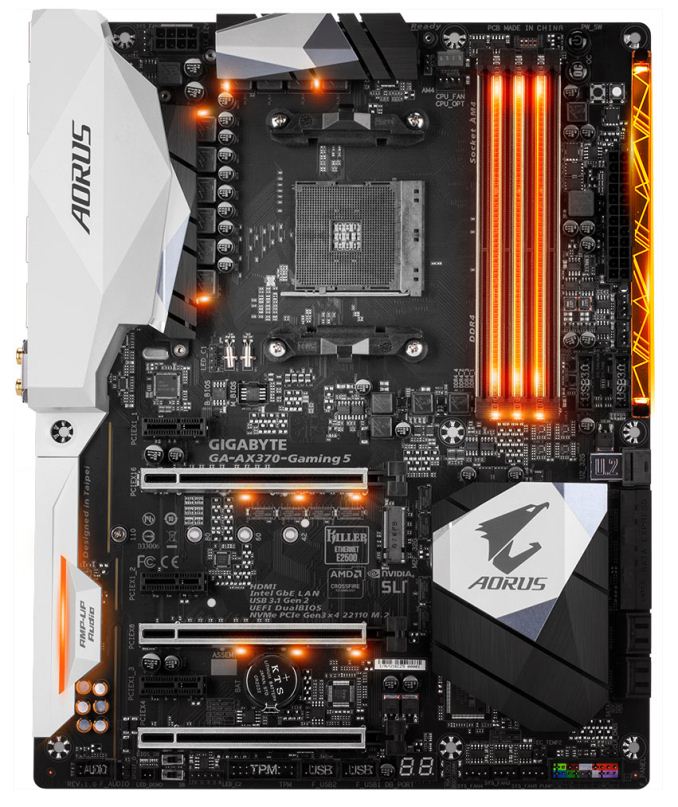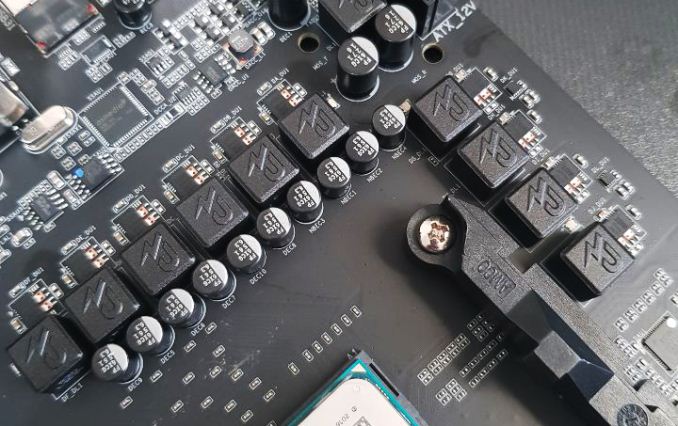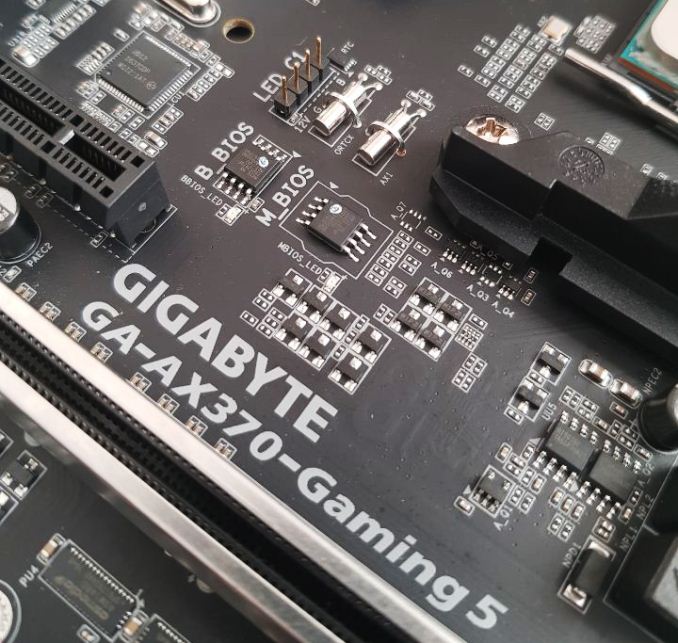The GIGABYTE Aorus AX370-Gaming 5 Review: Dual Audio Codecs
by Gavin Bonshor on November 14, 2017 12:30 PM ESTGIGABYTE Aorus AX370-Gaming 5 Board Features
The Gaming 5 has a lot about it if we factor in the high volume of connections and inputs on a sub $200 offering. Physically Gaming 5 has support for both 2-way SLI and 3-way CrossFire multi-graphics configurations, although theoretically there is support for up to 4-way SLI and 4-way CrossFire with GPUs featuring two GPU cores on a single PCB. GIGABYTE is known for emphasizing its onboard audio solutions on their range of upper-end boards, but the AX370-Gaming 5 features dual Realtek ALC1220 codecs with the second designed specifically for the front panel audio.
| GIGABYTE Aorus AX370-Gaming 5 ATX Motherboard | |
| Warranty Period | 3 Years |
| Product Page | Link |
| Price | $174 |
| Size | ATX |
| CPU Interface | AM4 |
| Chipset | AMD X370 |
| Memory Slots (DDR4) | Four DDR4 Supporting 64GB Dual Channel Up to 3200 MHz |
| Video Outputs | HDMI 1.4 |
| Network Connectivity | Killer E2500 & Intel I211-AT |
| Onboard Audio | Realtek ALC1220 |
| PCIe Slots for Graphics (from CPU) | 2 x PCIe 3.0 (x16, x8/x8) |
| PCIe Slots for Other (from PCH) | 1 x PCIe 2.0 (x4) 3 x PCIe (x1) |
| Onboard SATA | Eight, RAID 0/1/10 |
| Onboard M.2 | 1 x PCIe 3.0 x4, on Front |
| USB 3.1 (10 Gbps) | 1 x Type-C 3 x Type-A |
| USB 3.0 (5 Gbps) | 2 x Rear Panel 4 x Header |
| USB 2.0 | 4 × Header |
| Power Connectors | 1 x 24-pin ATX 1 x 8-pin CPU |
| Fan Headers | 1 x CPU (4-pin) 4 x System (4-pin) 2 x System/Pump (4-pin) |
| IO Panel | 6 x USB 3.1 (USB 3.1 Gen 1) 3 x USB 3.1 (USB 3.1 Gen 2) 1 x USB 3.1 Type-C 2 x Network RJ-45 1 x HDMI 1.4 1 x Combo PS/2 5 x 3.5 mm Audio Jacks 1 x Optical SPDIF Out Port |
Visual Inspection
The Gaming 5 has a wave of customisable RGB LED zones across multiple areas. Going from left to right, there is are subtly placed LEDs in the plastic audio component cover, and next to this are a couple of single LEDs placed at either side of the chokes in the VRM area. In the center, and under each of the two PCIe x16 3.0 slots, we get three LEDs forming a strip directly under the slots. On the right-hand side, there is an array of lighting in between the memory slots, and an LED bar on the right using a plastic pattern that can be replaced.
The top right-hand corner of the board features (what I like to call) 'a basic overclockers toolkit', and consists of a power button, a one-click OC button and small reset CMOS and system reset buttons. There also are five 4-pin PWM headers (including CPU) on the board, with two high-powered fan headers for users with water cooling pumps. The audio area has the pair of Realtek ALC1220 codecs, for both rear and front panel audio, which uses gold Japanese Nichon audio capacitors. Nippon Chemi-Con 10k solid capacitors are used elsewhere on the board and are black in colour.
Aside from the single and centrally located PCIe x4 NVMe M.2 storage slot, the rest of the storage options can be found on the lower right-hand side of the board. There are eight SATA 6Gb/s ports as well as two SATA Express ports. To the right is a single U.2 port as well.
With the power delivery, GIGABYTE is using a 10-phase digital power design. The VRM is controlled by am International Rectifier IR35201 digital PWM controller, running in 4+2 mode, with an IR3599 doubler bringing the count to 8+2. Supplementing the VRM controller, the board utilizes the International Rectifier IR3553M 40A MOSFETs and GIGABYTE's own designed ferrite core chokes.
One of the more premium features on the Gaming 5 is having a dual BIOS system. The BIOS in use can be selected via a switch on the board. At the bottom of the board just located below the bottom PCIe x16 slot are two switches which allow the user to change the configuration of the BIOS implementation: when switched into single mode, each of the two BIOS chips can run different BIOS versions (which is handy for overclockers who use different BIOS versions depending on the CPU model). When selecting the dual BIOS mode, they run in a mirror configuration; it reflects the image across both of the BIOS chips for redundancy purposes.
On the rear panel, there is single USB 3.1 Gen 2 Type-C port and single USB 3.1 Gen 2 Type-A port which are supported via the ASMedia ASM1143 USB controller. Also present is an additional two USB 3.1 Gen 2 type-A ports as well as six USB 3.0 ports and 3.5mm audio jacks for the onboard audio with S/PDIF output. A lot less emphasis has been placed on the onboard graphics as a there is only a single HDMI 1.4 output, with GIGABYTE showing its intent to market this board primarily to those planning on to use discrete graphics. There are two physical network ports, using the Rivet Networks Killer E2500 chip and the Intel I211-AT controller. Also present is a combination PS/2 port.














34 Comments
View All Comments
Samus - Wednesday, November 15, 2017 - link
True, but the problem is most of the DAC's have a lower overall quality than many high end onboard DAC's. Especially wireless headphones. Until I found the SteelSeries H (Now the Siberia I guess...) I had pretty much given up finding wireless headphones with a decent DAC.PeachNCream - Tuesday, November 14, 2017 - link
Killer NIC... *sad panda*Flunk - Tuesday, November 14, 2017 - link
Only an issue if you want two Ethernet ports, there is also an Intel NIC on there.wolrah - Tuesday, November 14, 2017 - link
@Flunk that doesn't excuse it, that makes it worse. They clearly understand that Intel NICs are better, but they only half-assed it. Killer is gimmicky garbage. It needs to go away.The only non-Intel network card I want to see on a motherboard is one of the NBaseT products, and only because Intel doesn't yet make one.
DanNeely - Wednesday, November 15, 2017 - link
No, it means they clearly understand the market. Of the people who care about the nic brand, half have drank killer's koolaid and know it makes them game better, and half know that intel's the way to go because their drivers are much less garbage than the competition. This lets them supply both of the main halves of the care about nic brand market. The group of people who care about nic brand and need 2 of them is much smaller; losing them and/or sending them to a different model in the lineup isn't a major loss.PeachNCream - Thursday, November 16, 2017 - link
Does Qualcomm still own the Killer NIC brand? I thought that was their product operating under a subsidiary.nismotigerwvu - Tuesday, November 14, 2017 - link
There's a typo on your conclusions page. It should read "gigabit ethernet" not "gigabyte ethernet".Dr. Swag - Tuesday, November 14, 2017 - link
Could you guys add some more in depth vrm stuff into the mix? Like current capabilites, vrm temp measurements, etc. A lot of AM4 boards have sub par VRMs that don't have proper temp protections and stuff, so it would be really nice if you guys could add some stuff that looks into this sort of stuff.Horza - Tuesday, November 14, 2017 - link
The VRM information is incorrect as far as I know. It's running in 6+2 mode with, as you said, doublers on the SOC VRM so it's 6+(2x2) not 8+2.Cooe - Saturday, March 24, 2018 - link
This is correct. The flagship K7 also uses the exact same 6+(2x2) VRM setup (in addition to everything else aside from it's inclusion of a external BCLK generator & additional LED strip on the I/O shield).